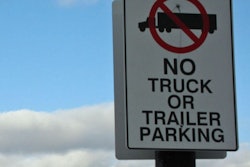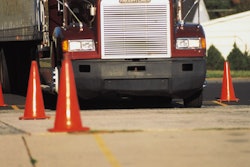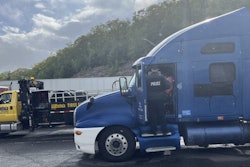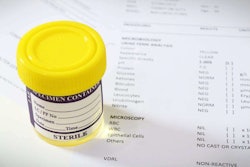With lighter loads, you should be letting air out of your tires rather than pumping them up to improve fuel economy and tire longevity.
Skillful truck drivers gear rpm to the load to save fuel when cruising and improve performance when climbing hills. But did you know that a similar principle applies to tire pressure? You should adjust it to match the load you’re carrying.
The tire’s contact patch should be as large as possible while keeping a healthy amount of pressure and maintaining even contact between all the areas of the patch and the road. That means adjustment to reach “the optimal pressure for the load,” rather than inflating the tire to the same cold pressure all the time, says Doug Jones, customer engineering support manager at Michelin North America.
“The first thing to do is weigh the vehicle and get accurate loads per axle and per tandem and determine the load on each tire position,” says Greg McDonald, an engineering manager at Bridgestone Firestone North America. Divide the axle load by the number of tires to get the load per tire.
Next, consult a chart that relates each tire’s load to pressure. “Every manufacturer has such a chart,” Jones says. Others are provided by the Technology and Maintenance Council and by the Tire and Rim Association, through its yearbook.

To read Goodyear’s heavy-duty truck tire chart, for example, first check the maximum load rating and pressure on your tire. Then match that size and maximum pressure rating with the maximum load rating as shown in bold on the chart.
Such a chart highlights the varying relationship between pressure and a tire’s ability to carry weight. Dual ratings are slightly lower than for tires mounted singly to allow for the inevitable uneven loading when pressure and diameter are not exactly the same. At 70 psi, one Goodyear 285/75R24.5 tire is rated to carry 4,540 lbs. as a dual and 4,545 lbs. mounted singly. At 100 psi, the weight ratings move up to 5,675 lbs. dual and 5,835 lbs. single. At 110 psi, the ratings are 6,175 lbs. dual and single.
Using a chart, set the psi by tire and position “to at least meet these specifications, not to exceed the tire and wheel’s maximum cold psi allowance,” McDonald says. That maximum pressure is stamped on the tire casing.
What happens if you have a rig designed to carry 80,000 lbs. and you’re carrying balloon freight, such as a large empty tank, that gives you a much lower gross combination weight rating? A standard rig loaded to 80,000 lbs. typically carries 34,000 lbs. on each tandem, or 4,250 lbs. per tire. If your GCW is only about 60,000 lbs. – meaning the cargo weighs 20,000 lbs. less than the maximum you can carry – your tandems each would carry about 24,000 lbs. That means your drive and trailer axle tires might not carry much more than 3,000 lbs. each, depending on your fifth-wheel setting.
Clearly, even if running tires rated to carry somewhat less than those mentioned above, you likely can adjust your pressures down to the lowest shown on the chart.
Leased operators, take note: “A lot of fleets have their own standard pressure recommendation, and don’t follow the chart,” Jones says. “Some fleets even overinflate for the sake of fuel economy. But if you’re not running the maximum load, you don’t need the maximum pressure. There is an optimal pressure for the load you’re carrying. It’s much better to follow the chart by knowing what your load is and adjusting tire pressure accordingly.”
That recommended pressure creates an optimized footprint, and “as the pressure is dropped, the footprint size grows,” says Tim Miller, Goodyear’s marketing communications manager. That means more rubber on the road.
The biggest benefit of that optimized footprint is the elimination of irregular wear that can prematurely condemn a tire. “Underinflation typically wears the shoulders of a tire faster than the center of the tread,” Miller says. “Overinflation results in the opposite effect, a fast-wearing tread center.”
When overinflated, the outer shoulders develop “erosion wear,” wearing only on their outside edges, according to a Bridgestone Firestone diagram. When underinflated, the second and fourth ribs, the ones between the shoulders and the center rib, develop rapid wear.
The classic scenario that causes overinflation wear is a never-adjusted tire on a trailer that runs empty a significant percentage of the time. Trailer tires experience the greatest drop in the weight when the trailer is unloaded since the drive tires carry the weight of the drivetrain at all times.
Another problem caused by not adjusting pressure downward at lighter loads is that overinflation results in a much rougher ride. Also, “When a tire is overinflated, it is more susceptible to puncture damage because it is less flexible,” Jones says.
“When an overinflated tire strikes a sharp edge like the edge of a pothole, at fairly high speed, it can literally ‘break’ the tread and casing, often opening a huge gash across the tread,” says the Bridgestone Firestone booklet “Real Questions, Real Answers: Why Are There Load and Inflation Tables?”
“The damage is so bad, the tire usually cannot be repaired or retreaded,” Jones says. “Also, because of the smaller footprint, there is a loss of traction and braking efficiency.” This loss of traction was a prime cause of trailer tire flat-spotting in the days before antilock brakes.
“Most of the inflation-related problems are still due to underinflation,” Jones says. “You get heat buildup, and flexing will fatigue the cables.”
And once you’ve congratulated yourself on dropping pressures for a light load, don’t forget to get them back up to the proper level once you go back to carrying maximum weights. Otherwise, you will have been too smart for your own good.
A narrow loophole for the heaviest loads
Using the limits stated in tire-pressure charts, tires may be run beyond the rating shown on the sidewall provided the weight is within the specified higher limit, pressure is properly adjusted to a level above what would normally be used, and a specified speed is not exceeded.
Running in this overload situation at the maximum rated speed “will compromise the tire” even if the pressure has been properly adjusted, says Doug Jones of Michelin. So even if road conditions permit, don’t run faster than that allowable reduced speed.
For most truckers, this type of operation is impractical even though the reduced speed and higher pressure will prevent damage to the tire, Jones says – and not just because it’s hardly ideal to run at low speed on an Interstate.
“It is illegal to run on the highway with a load that is higher than the rating of your tires,” he says. Such operation is appropriate only on private property, as on a factory access road or logging road, or in the dirt.
Beware of “run flats”
Any tire that has been run 20 percent or more underinflated must be considered a “run flat,” says Doug Jones of Michelin.
This means it must be demounted and inspected inside and out, because the damage often is insidious and can show up many hundreds of miles later as a sudden tire failure. If the pressure was 50 percent or less, the tire is almost sure to have sustained at least some internal damage, Jones says.
After a careful inspection, remount the tire, put it in an inflation cage to protect yourself, and inflate it very slowly, listening carefully to what is going on inside the tire. If you hear a crackling noise at any point as the tire is gradually inflated, “the cables came apart,” Jones says. “Immediately deflate the tire, remove it from the rim and scrap the casing.”











